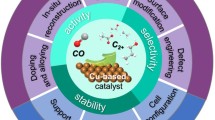Summary
A hypothesis for the reason of the anomaly, observed in Cu(II)-complexone systems with two types of solid-state homogeneous Cu-ISEs, one based on pressed pellets of ternary CuAgSe and the other on thin-layer electroplated Cu2-xSe is presented. It is grounded on the results of systematic investigations of these sensors in 13 different Cu(II)-L systems (where carboxylic acids, amino-acids and polyaminopolycarboxylic acids have been taken as ligands) and on the electrodes' response to copper(I). Its main point is that the electrodes being primary for Cu(I) as suggested by the selectivity coefficients, KCu+, Cua+, act as Cu(II)-electrodes through the fast exchange reaction:
and that at very low Cu(II) concentration the [Cu+]0E-activity, generated by the exchange reaction becomes commensurable with the native [Cu+]0α-surface activity characteristic for the membrane material. The hypothesis has been verified experimentally. By blocking the native Cu(I)-surface activity with glycine, the anomaly, observed in Cu(II)-NTA solution disappears and decreases considerably in Cu(II)-EDTA and Cu(II)-DTPA solutions.
Similar content being viewed by others
References
E. Hansen, C. G. Lamm, and J. Ruzicka, Anal. Chim. Acta59, 403 (1972).
G. Nakagawa, H. Wada, and T. Hayakawa, Bull. Chem. Soc. Japan48, 424 (1975).
Y. Umezawa, Y. Imanishi, K. Sawatari, and S. Fujiwara, Bull. Chem. Soc. Japan52, 945 (1979).
W. E. van der Linden and G. J. M. Heijne, Anal. Chim. Acta96, 13 (1978).
G. Nakagawa, H. Wada, and T. Sako, Bull. Chem. Soc. Japan53, 1303 (1980).
A. Hulanicki, M. Trojanowicz, and M. Cichy, Talanta23, 47 (1976).
M. Neshkova and H. Sheytanov,,32, 937 (1985).
M. Neshkova and H. Havas, Hung. Patent 174627 (31. August 1976); Anal. Lett.16, 1567 (1983).
M. Neshkova and H. Sheytanov, J. Electroanal. Chem.102, 189 (1979).
A. Hulanicki, T. Krawczynski vel Krawszyk, and A. Lewenstam, Anal. Chim. Acta158, 343 (1984).
M. Neshkova and H. Sheytanov, Talanta32, 654 (1985).
R. P. Buck, Anal. Chem.40, 1432 (1968).
E. Pungor and K. Toth, Analyst95, 625 (1970).
T. Hepel, M. Hepel, and M. Leszko, Analyst102, 132 (1977).
W. E. Morf, G. Kahr, and W. Simon, Anal. Chem.46, 1538 (1974).
H. Stünzi, Talanta29, 75 (1982).
G. J. Heijne and W. E. van der Linden, Anal. Chim. Acta93, 99 (1977).
Author information
Authors and Affiliations
Rights and permissions
About this article
Cite this article
Neshkova, M., Sheytanov, H. On the anomalous behaviour of two types solid-state copper(II)-ion-selective electrodes in presence of complexones-a possible explanation. Mikrochim Acta 86, 161–169 (1985). https://doi.org/10.1007/BF01197815
Received:
Issue Date:
DOI: https://doi.org/10.1007/BF01197815




